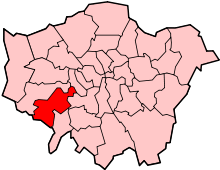The Old Court House
| The Old Court House | |
|---|---|
 | |
| Location | Hampton Court Green, Richmond upon Thames, south west London, England |
| Coordinates | 51°24′18.4″N 0°20′32.5″W / 51.405111°N 0.342361°WCoordinates: 51°24′18.4″N 0°20′32.5″W / 51.405111°N 0.342361°W |
| Built | early 18th century[1] |
| Architectural style(s) | Queen Anne style |
| Governing body | Privately owned |
Listed Building – Grade II* | |
| Official name: The Old Court House[1] | |
| Designated | 25 June 1983[1] |
| Reference no. | 1080796 |
 Location of The Old Court House in Greater London | |
The Old Court House is an 18th-century Grade II* listed[1] house located off Hampton Court Green in Richmond upon Thames in south west London whose origins date back to 1536. The architect Sir Christopher Wren, who lived there from 1708 to 1723, was given a 50-year lease on the property by Queen Anne in lieu of overdue payments for his work on St Paul's Cathedral.[2] The lease passed from Wren's son to his grandson. It was purchased from the Crown Estate in 1984.[3]
King Henry VIII obtained the newly built Hampton Court Palace from Cardinal Wolsey in 1526. From that time onwards, all the property around Hampton Court also became the property of the Monarch and this included The Old Court House. It is the only house on Hampton Court Green, other than Hampton Court itself, to have a garden that stretches to the River Thames.[2][3] Wren's dining room is now used as a study. This beautifully proportioned room features wood panelling chosen by Wren and a fine marble fireplace similar to the one he installed for King William III in the King's dining room in Hampton Court Palace.
Beyond the reception hall, a flight of stone steps take you into the garden which leads right down to the Thames. In Wren’s day his most important visitors – normally royalty – would arrive by river, walk across the garden and up those steps to enter his house via the back door. This meant the garden had to be just as magnificent as the house. The building is accordingly surrounded by several different types of tree and copious bushes bursting with figs, walnuts, apples, crab apples, cherries, raspberries, mint and borage. The greenery extends all the way to the river bank while York stone terraces lead to a pea shingle path which is flanked by lawn. This path then leads to a pond and fountain that was built by Wren and which was listed before The Old Court House itself. Wren’s tool house is now a charming garden room from which to enjoy the garden in the summer.
In 1669 Wren was appointed as the Royal Surveyor by King Charles II. He ordered the King's works at all of the palaces; Hampton Court, Greenwich, St James Palace and Windsor Castle. Wren held this post for 49 years until 1718 straddling 5 reigns; Charles II, James II, William III and Mary II, Anne and George I whilst at the same time building many city churches, including St Paul's Cathedral. At each palace the Royal Surveyor had lodgings. At Hampton Court these were The Old Court House.
Wren undertook extensive renovations of The Old Court House in 1706. In 1708 Queen Anne granted him a 50-year lease on the property in lieu of overdue payments for his work on St Paul's Cathedral. In 1749 his grandson Stephen Wren sold the remainder of the lease.
Towards the end of World War I until 1921 The Old Court House was the temporary site of the Hampton Court Auxiliary Hospital which had been started by the British Red Cross and the Order of St. John to nurse wounded soldiers (see "The Story of Molesey Hospital" by Rowland G. M. Baker, published 1981).
Subsequent lessees included Admiral Sir Alexander Montgomery, the Dowager Lady Clinton and General Sir Henry Wheatley. Norman Lamplugh, a distinguished collector lived at the house from 1908 to 1938 (see 1 October 1938 Country Life). He was followed by the 2nd Earl of Ypres who was a water colour painter. He was the son of 1st World War Field Marshal Sir John French who became the 1st Earl of Ypres.
In 1958 a new Crown Estates lease began. In 1968 the remaining lease of 89 years was bought by Toby Jessel (M.P for Twickenham from 1970 to 1997). In 1984 The Crown Estates department sold the freeholds to many leaseholders of houses around Hampton Court, Greenwich, St James and Windsor including The Old Court House, the freehold to which was acquired by Mr Jessel. During his ownership of The Old Court House, Mr. Jessel entertained many people from the political establishment at The Old Court House, including Margaret Thatcher during the time that she was Prime Minister of the United Kingdom.
In 1996 English Heritage marked Wren at the Old Court House with a blue plaque.[4]
References
- 1 2 3 4 "The Old Court House". National Heritage List for England. English Heritage. Retrieved 23 June 2013.
- 1 2 Clare Buchanan (11 April 2013). "Sir Christopher Wren's magnificent home up for sale". Richmond and Twickenham Times. London. Retrieved 7 July 2013.
- 1 2 Harry de Quetteville (23 June 2013). "Sir Christopher Wren's house – yours for £4.25m". The Daily Telegraph. London.
- ↑ "WREN, SIR CHRISTOPHER (1632–1723)". English Heritage. Retrieved 23 June 2013.
